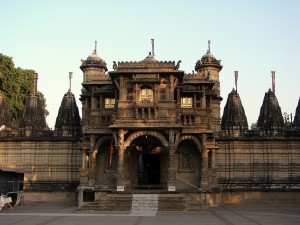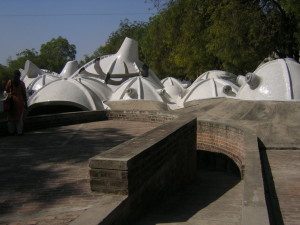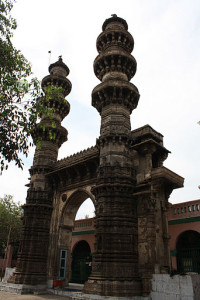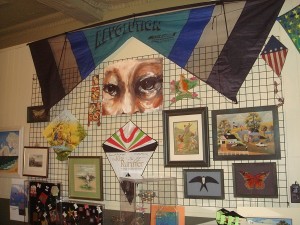Here are few most important places to visit in Ahmedabad. There are many historic and modern places in the city for the people to visit at least once in their life time. Ahmedabad is also called as Karnavati which is the largest city in Gujarat. It is the seventh biggest metropolitan city in India located on the banks of river Sabarmati. This city was founded in the year 1411 by Sultan Ahmed Shah which served as the capital city of Gujarat Sultanate and the city was named after him. When British ruled India they developed a military bas in the city and the cities infrastructure expanded and got modernized. As a result even now we can found many famous buildings in European style infrastructure. Indian independence movement developed very strongly in the city when Mahatma Gandhi opened Kochrab Ashram in 1915 near Paldi and Satyagraha Ashram now called as Sabarmati Ashram on the banks of river Sabarmati in 1917 which became a intense nationalist activities centers.
Adalaj Stepwell/Vav:

It is a very unique water building of Hindus present in the Adalaj village, very close to Ahmedabad in Gandhinagar district. The stepwell was built by Muslim king Mohammed Begda in the year 1499 for the Queen Rani Roopba. The stepwell is also called as Vav in native Gujarati is basically carved completely and it is of 5 stories in depth. These stepwell once served as the basic water needs for the different regions of Gujarat and most of the time great festivals and sacred rituals were celebrated in these stepwell. Stepwells are considered to be built between 5th and 19th century and we can found around 120 stepwells in and around Gujarat. They are mainly used to collect rain water during monsoon and serve as the basic water sources for people in rest of the different seasons. This Adalaj stepwell is built in the style of Indo-Islamic architecture by making use of sand stones. The structure of this stepwell is octagonal in shape when viewed from the top. The five stories deep building has many pillars carved in different styles to support the gigantic structure. It was dug so deep so that it is helpful to access under ground water when ever there is less amount of rain. The main feature of this building is from the first level there are three staircases connecting the bottom level of the building which connects directly to access the under ground water. The walls are carved so beautifully which depicts the daily activities of human beings like woman churning butter milk, dancers performing a show and king looking over into it. The architecture of this building is so amazing and it is indicator of the historic style of India. And it is the best venue to visit whenever you go to Gujarat.
Jama Masjid:

This Masjid was built in the year 1423 by Sultan Ahmed Shah. This whole mosque is build with help of yellow sand stones in the style of both Hindu and Muslim architecture. This mosque has 260 pillars supporting the 15 domes which are constructed in multiple elevations in the different locations of mosque. It has a vast surfaced courtyard rectangle in shape of dimension 75 meters by 66 meters. The whole western chamber is a very big hall supported by 260 pillars which are carved in the style of Hindu and Jain religion. The central courtyard can be accessed from the East and also it has 3 other entrances. The courtyard is surfaced with white marbles completely and it has a pool in the centre which is very attractive. Also this mosque has a sanctuary which tells the interest and humanity of people towards the animals. And this has been looked over very nicely till date and it is very splendid to watch. Near the eastern entrance we can see the tomb of Sultan Ahmed Shah which is also called as Roja. This tomb has 3 graves of most important rulers of Gujarat like Ahmed Shah I, Mohammed Shah and Qutub-Ud-Din Ahmed Shah II. To construct this very beautiful building it took 13 years and even today after years of continues variations of climate and whether this mosque stands firm and is used by most of the residential Muslim people for prayers. This has got variety of architectural design which should be seen by all the Indians at least once which tells the glory of past India. The designs are so marvelous that you cannot stop watching them once started.
Hatheesing Jain Temples
A rich Jain merchant built this temple outside Delhi Gate in 1850. It is built of pure white marble and profusely decorated with rich carvings, dedicated to Dharamnath, the 15th Jina or Jain apostle. Embellished with intricate carvings and built in white marble, the Hatheesing Jain temple is one of the best ornate Jain temple in Ahmedabad.
This temple was built in the nineteenth century by a rich Jain merchant. This profusely decorated temple is dedicated to 15th Jain tirthankar or Jain Apostle- Dharmnath. Built outside Delhi Gate by Sheth Hatheesing, this is the best known of Ahmedabad’s many ornate Jain Temples. Built of pure white marble, it has a paved courtyard surrounded by an imposing row of cloisters containing 52 shrines, each with an image of a tirthankara, profusely decorated with rich carvings, one containing the marble image of the 15th tirthankar. The temple is a two-storied structure with elaborate porches on three sides and front porch crowned by a large dome. It was designed by Premchand Salat and is dedicated to Dharmanath, the fifteenth Jina or Jain apostle. It was built at a cost of Rs 10 Lakhs, a sum unimaginable in those days. Built outside Ahmedabads’ Delhi Gate.
Hussain Doshi gufa
Hussain Doshi Gufa is an underground art gallery located in Ahmedabad that depicts the works of the famous Indian painter named M.F.Hussain. It has been designed by the famous architect B. V. Doshi. Thus, the art gallery has been named after the two eminent personalities, Hussain and Doshi. The gallery is more popularly known as Amdavad ni Gufa. It has been given the name Gufa, as its structural design resembles a cave. For the art lovers, Hussain Doshi gufa is a real feast for eyes. The Hussain Doshi Gufa art gallery in Ahmedabad lies in the surrounding areas of the Center for Environmental Planning and Technology. This structure has been constructed using simple hand tools and that too by unskilled workers. The art gallery has been built on the basis of computer aided designs.
Calico Museum:
It is a museum of textile located in the city of Ahmedabad which was founded by Gautam Sarabhai an industrialist and his sister Gira Sarabhai in the year 1949. Currently the museum is managed by Sarabhai foundations. The museum was originally started in Calico Mills in the heart of textile industry but was later shifted to Sarabhai House in Shahibaug as the collection in the museum increased. It is considered as the finest textile museum in the world as it has very good collections of rare textiles from 17th century. This museum contains not only textiles and cloths but also a rare collections of temple artifacts of the country, rare furniture with variety of eye catching designs, marbles, fine fabrics spun, painted and printed etc… The gallery section is divided into 2 main themes called as historical textiles and religious textiles. In historical textiles section you can see different types of cloths and fabrics used before thousands of years. And the religious section displays different types of dresses used by different religious people all over India. Cloths with tie- dye, screen prints, glinting mirror work, intricate embroidery and block prints are also seen. There are also elaborate carpets, screens and lump cushions that were once used in the Muslim palaces. There is also a library of textiles where you can see books bases on the different styles of dresses and crafts. This is the famous place to visit for all people especially for craft and fabrics lovers where you can see different styles of clothes at one place.
Swaminarayan Temple
Explore the old city’s narrow streets to find the glorious, multi-coloured, wood carved Swaminarayan Temple. A great, grand haveli (traditional, ornately decorated residence) dating from 1850, Swaminarayan Temple is enclosed in a large courtyard and is one of the leading places to visit in Ahmedabad, India.
Ahmed Shah Tombs
The tomb of Ahmed Shah, with its perforated stone windows, stands just outside the east gate of the Jama Masjid. His son and grandson, who did not long survive him, also have their cenotaphs in this tomb. Women are not allowed into the central chamber. Across the street on a raised platform is the tomb of his queens – it’s now really a market and in very poor shape compared to Ahmed Shah’s tomb.
Rani Sipri Mosque
A little south-east of the centre this small mosque was built in 1514 and is also known as the Masjid-e-Nagira or ‘jewel of a mosque’ due to its extremely graceful and well executed design. Its slender, delicate minarets are again a blend of Hindu and Islamic styles.The mosque is said to have been built by a wife of Sultan Mehmood Begada after he executed their son for some minor misdemeanour.
Rani Rupmati Mosque
Named after the Hindu wife of Sultan Mehmed Beghara, Popularly known as Masjid-e-Nagina, this mosque is the most exquisite gem of Ahmedabad. This mosque was built between 1430 to 1440 A. D. having three domes supported by pillars with the central dome slightly elevated to allow natural light into the mosque. The tomb of Rani Rupmati is next to it. Rani Rupmati Masjid named for the princess of Dhar who married the Sultan of Ahmedabad, is another fine example of the Indo-Sarcenic blended style. A high central arch, 3 imposing domes, slim minarets, carved galleries and an exquisite mihrab are the high points. Its three domes are linked together by a flat roof. However, the mosque and tomb of Rani Sipri at Astodia surpasses it for its planning and structural arrangement.
Chandola Lake
Situated at the Dani Limda Road, Chandola Lake in Ahmedabad is an artificial lake. The credit for establishing it goes to the wife of a Mughal Sultan of Ahmedabad named Tajn Khan Nari Ali. Chandola Lake is basically a water reservoir, which is very beneficial for the people of Ahmedabad. The water of Chandola Lake is used for irrigation as well as other industrial purposes.
Kankaria Lake
Kankaria Lake is another tourist attraction of Ahmedabad. The Kankaria Lake is a circular lake constructed in AD 1451 by Sultan Qutub-ud-din. Amongst the places to be visited in the lake is the island garden at its centre with a summer palace known as Nagina Wadi. Lush green parks, an aquarium, a boat club, a natural historical museum, and a zoo surrounding the park make the lake a place to be seen in Ahmedabad. The ‘Bal Vatika’ or the children’s park makes it a great picnic spot and attracts tourists and localities from Ahmedabad alike.
Tribal museum
Tribal museum is located inside the campus of Tribal research and training institute, Ahmedabad.It was established in 1962.This museum gives a detailed picture of the tribal life of the region. Tribal museum contains different types of ethnological objects including ornaments, toys, masks, charts, photos, slides, flims of tribal life and household objects agricultural implements. Tribal museum is open on all days from 12 pm to 5pm leaving Sundays and public holidays.
Sabarmati Gandhi Ashram
The Gandhi Ashram situated alongside the Sabarmati River, was the nerve center for the Indian Freedom movement. The beautiful ashram complex with it’s shady trees offers a refuge from the loud streets of the city. There is a museum inside the Ashram complex. During the lifetime of Mahatma Gandhi it was known as Satyagraha Ashram. After Gandhiji’s return from South Africa, he decided to settle in Ahmedabad. It was for four reasons that he selected this place – In his own words “being a Gujarati, I’ll serve my country best through the use of Gujarati language.
Sardar Patel national memorial
As the name suggests, Sardar Patel national memorial was established in the memory of Sardar Vallabhbhai Patel, who was a great freedom fighter. Located in the environs of Shahibaugh in Ahmedabad, Sardar Patel national memorial museum is also known as Moti Shah Mahal. A major attraction of the Sardar Patel national memorial museum in Ahmedabad consists of the national flag that was designed by the Indian National Congress in 1930 -1931. The museum houses various portraits of Sardar Patel, his family members and friends. You can also find the biography of Sardar Patel in the museum, which contains a detailed description of all the phases of his life.
Sidi Sayed Mosque
Most predominant shrine of the Muslim community in Ahmedbad, Sidi Sayed Mosque, proffers all the glittering facets of a classy structure. It is renowned for the acclaimed fabulous Jhali screen, locates in the ten semi-circular windows. Among these windows the two that are placed on the western walls are very impressive with magnificent carvings and designs. The mosque depicts the usual yellow colour, which is quite common about the shrine of that area, but elaborate floral and architectural works made it so different from that of the others. A perfect example for the Indo-Sarcenic style, this mosque shows how a simple stone can be changed in to filigree. Do not forget to buy the miniature models of the shrine and other classic edifices with in it while on your trip.
Shaking minaret
Shaking minaret is one of the most beautiful tourist places in the city. Due to its construction, the mosque is also called Jhulta minar. It is believed that shaking minaret is constructed by Sidi Bashir, a salve of sultan Ahmed Shah. This monument was completed in 1452.There are many beliefs about shaking minaret, according to popular belief it was done to avoid the earthquakes. It is said that a European Sanskrit schlor, Monier M Williams that the minarets are shaking. So this was known by the name of shaking minaret or Jhulta minar.
kite museum
One of the most unique museums in Ahmedabad. The kite museum is located in Sanskar Kendra in Ahmedabad that houses an extraordinary collection of rare kites built over 50 years by a man called Bhanubhai Shah. From kites that have been crafted from 400 pieces of paper to the uniquely kites of unique colors, the kite. This unique kite museum was established in the year 1985.It contains different types of kites from all over the world. It was possesses many photographs of kites. The kite museum is one of the most beautiful tourist attractions of Ahmedabad.
Vishalla museum
Vishalla utensils museum is located in the compound Vishalla restaurant. It is started by interior designer Surendra Patel.Vishalla utensils museum houses over more than 2000 varieties of traditional Indian utensils in curious shapes and sizes. This museum has a good collection of boxes, utensils, pots, scales and pipes.
Bhadra Fort
Bhadra Fort was built by the city’s founder, Ahmed Shah, in 1411 and later named after the goddess Bhadra, an incarnation of Kali. There were royal palaces and a garden inside the fort. It now houses government offices. To the east of the fort stands the triple gateway or Teen Darwaja, from which sultans used to watch processions from the palace to the Jama Masjid. The royal entrance is triple arched and richly carved.



















